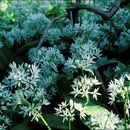en
names in breadcrumbs


Ł'Ajo selvadego (nome sientifego Allium ursinum deła fameja dełe Liliaceae) xe na erba selvadega ke crese 'ntel sotobosco in piano, in cołina e in montagna.
I nomi in todesco (Baerlauch), in inglexe (bear's garlic o ramsons) e in taljan (aglio ursino) i vol dire tuti ła stesa roba: ajo deł'orso.
Alta dai 20 ai 40 cm, sta pianta ła manda un forte odore de ajo.
Ła buta fora, fra febraro e marso, do foje ovałi verde scuro (xe deso ke bisogna torle su).
In aprile e majo vien fora i fioreti bianchi, a forma de steła, con sie petali.
Cołe foje, ma anca coi bulbi, se pol fare salse e anca darghe saor ałe insałate.
Ł'Ajo selvadego (nome sientifego Allium ursinum deła fameja dełe Liliaceae) xe na erba selvadega ke crese 'ntel sotobosco in piano, in cołina e in montagna.
Hramsan, buccramsan oþþe berangārlēac (Allium ursinum) is ƿilde sibling secglēaces. The systematic name derives from the fact that brown bears like to eat the bulbs of the plant and dig up the ground to get at them, as do ƿilde bār.
Ƿildu lēac grōƿaþ mainly in swampy deciduous woodlands. They flower before the trees get their leaves and fill the air mid hira gecyndan strangan stence.
Þā lēaf sind gegadrod and geeten sƿā lāctricdisc, gesoden, oþþe sƿā pestocynn. Hīe ƿǣron gebrocen sƿā fōddor ēac. Cȳ þe fēddon on hramsan, giefaþ meolc þe bȳrgaþ hƿōnlīce sƿā gārlēac, and butere gemacod of þisse mielc ƿæs ǣr sƿīðe ƿīdmǣrsod in 19an gēarhundrede in Sƿitzerlande.
Hramsan ƿurdon nīƿlīce ƿīdcūþ in Þēodisclande, and in þǣm tūne Eberbach, feormaþ man gēarlicne hramsena frēols in Hrēþmōnþe and Ēastermōnþe.
Hramsan may grow in great numbers, as in this woodland in North Devon, England
Hramsan, buccramsan oþþe berangārlēac (Allium ursinum) is ƿilde sibling secglēaces. The systematic name derives from the fact that brown bears like to eat the bulbs of the plant and dig up the ground to get at them, as do ƿilde bār.
Ƿildu lēac grōƿaþ mainly in swampy deciduous woodlands. They flower before the trees get their leaves and fill the air mid hira gecyndan strangan stence.
Þā lēaf sind gegadrod and geeten sƿā lāctricdisc, gesoden, oþþe sƿā pestocynn. Hīe ƿǣron gebrocen sƿā fōddor ēac. Cȳ þe fēddon on hramsan, giefaþ meolc þe bȳrgaþ hƿōnlīce sƿā gārlēac, and butere gemacod of þisse mielc ƿæs ǣr sƿīðe ƿīdmǣrsod in 19an gēarhundrede in Sƿitzerlande.
Hramsan ƿurdon nīƿlīce ƿīdcūþ in Þēodisclande, and in þǣm tūne Eberbach, feormaþ man gēarlicne hramsena frēols in Hrēþmōnþe and Ēastermōnþe.
Халяар (Allium ursinum) нонгинын түрэлэй ногоон (эндэ үнгэ тухай хэлэгдэнэгүй, гэбэшье үнгэньшье мүн лэ ногоон байха) ургамал. Витамин ехэтэй энэ ургамалые хүнүүд урда галабhаа нааша суглуулжа, бүхэли үбэлдөө эдеэ хоолдоо холижо хэрэглэдэг. Хабарhаа эхилжэ 1,5-2 hарын туршада, ургажа захаламсаарнь суглуулдаг. Халяарай ургаса үсөөржэ байна гээд элирүүлэгдэнхэй, тиимэhээ тэрэниие огродтоошье тарижа ургуулхада болохо. Байгал шадарай бүхы аймагуудаар ургадаг, зарим газартаа ехэ талмайда айхабтар үдхэнөөр ургадаг.